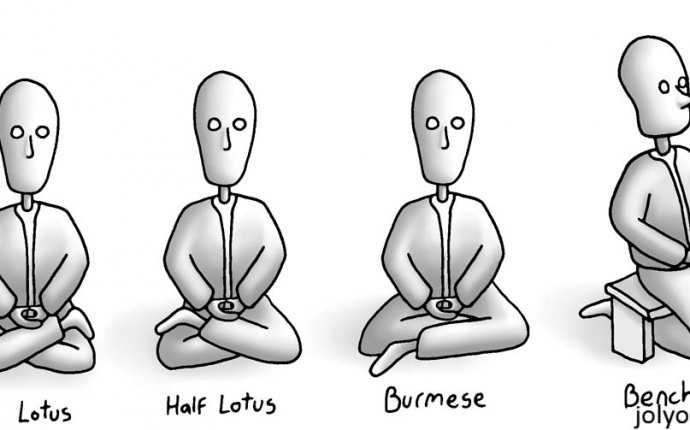
Meditation Posture for Beginners
If you examine the meditation poses depicted in the world’s great spiritual traditions, you’ll find that they all have one thing in common — the unshakable stability of a mountain or tree. Look at the kneeling pharaohs in the Egyptian pyramids, for example, or the cross-legged Buddhas in Indian caves or Japanese temples. They sit on a broad base that appears to be deeply rooted in the earth, and they have a grounded presence that says, “I can’t be budged. I’m here to stay.”
When you sit up straight like a mountain or a tree, your body acts as a link between heaven and earth — and by analogy, connects your physical, embodied existence with the sacred or spiritual dimension of being. In addition to the spiritual aspect, you might consider that sitting up straight confers some practical benefits as well. By aligning the spine and opening the channels that run through the center of the body, upright sitting encourages an unimpeded circulation of energy, which, in turn, contributes to wakefulness on all levels — physical, mental, and spiritual. Besides, it’s a lot easier to sit still for extended periods of time when your vertebrae are stacked like a pile of bricks, one on top of the other. Otherwise, over time, gravity has this irritating habit of pulling your body down toward the ground — and in the process, causing the aches and pains so typical of a body at war with the forces of nature. So, the most comfortable way to sit in the long run is straight, which puts you in harmony with nature.
Of course, you can always lean against the wall — or so you may think. But your body tends to slouch when it leans, even subtly, in any direction; and the point of doing meditation is to rely on your direct experience, rather than to depend on some outside support to “back you up.” When you sit like a mountain or a tree, you’re making a statement: “I’m deeply rooted in the earth, yet open to the higher powers of the cosmos — independent, yet inextricably connected to all of life.”
Take your position
Just as a tree needs to set down deep roots so it won’t fall over as it grows, you need to find a comfortable position for the lower half of your body that you can sustain for 5 or 10 or 15 minutes — or even longer, if you wish. After several millennia of experimentation, the great meditators have come up with a handful of traditional postures that seem to work especially well. Different though they may appear from the outside, these postures have one thing in common: the pelvis tilts slightly forward, accentuating the natural curvature of the lower back.
The following poses are arranged more or less in order, from the easiest to the hardest to do, though ease all depends on your particular body and degree of flexibility. For example, some people take to the classical lotus position (whose name derives from its resemblance to the flower) like a duck to . . . well, to a lotus pond. Besides, the lotus, though difficult, has some definite advantages, and you can work up to it.
- Sitting in a chair: The trick to meditating in a chair is positioning your buttocks somewhat higher than your knees, which tilts your pelvis forward and helps keep your back straight. (See Figure 1.) Old-fashioned wooden kitchen chairs work better than the upholstered kind; experiment with a small cushion or foam wedge under your buttocks. Don’t slouch.
Figure 1: Position your buttocks a bit higher than your knees.
- Kneeling (with or without a bench): This technique was popular in ancient Egypt and in traditional Japan where it’s called seiza (see Figure 2.). Kneeling can be — well, hard on your knees, unless you have proper support. Try placing a cushion under your buttocks and between your feet — or use a specially designed seiza bench, preferably one with a soft cushion between you and the wood. Otherwise, your bottom and other tender parts may fall asleep.
Figure 2: Kneeling can be hard on your knees, so try to add some cushioning.
- Easy position: Not recommended for extended periods of sitting because it’s not very stable and doesn’t support a straight spine. Simply sit on your cushion with your legs crossed in front of you tailor-fashion. (Believe it or not, tailors once sat this way!) Your knees don’t have to touch the floor, but do keep your back as straight as you can.
- You can stabilize the position by placing cushions under your knees; gradually decrease the height of the cushions as your hips become more flexible (which they naturally will over time). When your knees touch the ground, you may be ready for Burmese or lotus position (see later bullets for these positions).
- This pose can be a short-term alternative for people who can’t manage the other positions in this list, can’t kneel because of knee problems, or don’t want to sit on a chair for some reason.
- Burmese position: This pose, shown in Figure 3, is used throughout Southeast Asia. This pose involves placing both calves and feet on the floor one in front of the other. Although less stable than the lotus series, it’s much easier to negotiate, especially for beginners.









